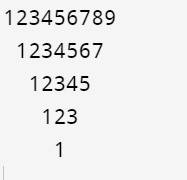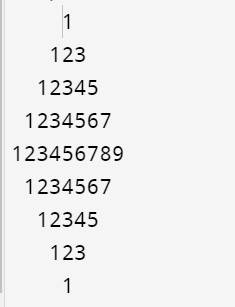Number Pattern in Python
Pattern programs in Python are a type of problem that uses nested loops to produce different patterns of numbers, stars (*), or other characters. In this blog, we will dive deeper, specifically into number pattern in Python programming language!


Basic Approach to Solve a Number Pattern in Python Using an Example
Step 1: Understand the Pattern
- Visualize the Pattern: Observe the pattern to understand its structure.
- Identify the Number of Rows and Columns: Determine the number of rows and columns in the pattern.
- Analyze the Sequence: Understand how the numbers are arranged in each row and column.
Example Pattern
Step 2: Determine and Set the Number of Rows
n = 5 # Number of rows
Step 3: Construct an Outer Loop for Rows
Create the Outer Loop: Set up an outer loop to iterate through the rows.
for i in range(1, n + 1): # Inner loop will go here
Step 4: Construct Inner Loops for Columns
Create Inner Loops for Columns: Utilize inner loops to manage the columns and print the numbers.
for j in range(1, n + 1): if i == 1 or i == n or j == 1 or j == n: print("5", end=" ") else: print(" ", end=" ")
Step 5: Combine and Execute the Code
Combine All Code Segments: Combine all parts and run the program to print the pattern.
n = 5 # Number of rows
for i in range(1, n + 1): for j in range(1, n + 1): if i == 1 or i == n or j == 1 or j == n: print("5", end=" ") else: print(" ", end=" ") print()
Following the above steps, you can systematically approach and solve any number pattern in python.
Best-suited Python courses for you
Learn Python with these high-rated online courses
Top Number Pattern Programs in Python
- Right-Angle Triangle Pattern
- Inverted Right-Angle Triangle Pattern
- Pyramid Number Pattern
- Inverted Pyramid Number Pattern
- Diamond Number Pattern
Let’s understand each of these one by one in detail
Right-Angle Triangle Pattern: A simple pattern where each row contains increasing consecutive numbers.
Code
for i in range(1, 6): for j in range(1, i + 1): print(j, end=' ') print()
Inverted Right-Angle Triangle Pattern: Similar to the right-angle triangle pattern but inverted.
for i in range(5, 0, -1): for j in range(1, i + 1): print(j, end=' ') print()
Pyramid Number Pattern: A pattern of numbers arranged in the form of a pyramid.
n = 5
for i in range(n): # Print spaces print(" " * (n - i - 1), end="")
# Print ascending numbers for k in range(1, i + 2): print(k, end="")
# Print descending numbers for l in range(i, 0, -1): print(l, end="")
# Move to the next line print()
Inverted Pyramid Number Pattern: An inverted version of the pyramid number pattern.
n = 5
for i in range(n, 0, -1): # Print leading spaces print(" " * (n - i), end="")
# Print the number pattern for k in range(1, i * 2): print(k, end="")
# Move to the next line print()
Diamond Number Pattern: A pattern where numbers are arranged in a diamond shape.
n = 5
# Upper half of the diamondfor i in range(1, n + 1): print(" " * (n - i), end="") for k in range(1, i * 2): print(k, end="") print()
# Lower half of the diamondfor i in range(n - 1, 0, -1): print(" " * (n - i), end="") for k in range(1, i * 2): print(k, end="") print()



Conclusion
Thus, number pattern in python is an essential part of foundational programming learning and practice. They not only help in understanding the use and manipulation of loops and control statements but also enhance logical thinking and problem-solving skills.
FAQs
What is a Number Pattern in Python?
A number pattern in Python refers to a sequence or arrangement of numbers in a specific order or shape, often displayed in rows and columns. These patterns are used to practice and understand loops, conditional statements, and the overall flow control in Python.
What are the Types of Number Patterns One Can Create in Python?
Common types of number patterns include straight sequences, pyramid shapes, inverted pyramids, diamond shapes, and more complex forms like Pascal's triangle or Fibonacci series patterns. The patterns can vary in complexity from simple linear sequences to more intricate nested arrangements.
Why are Number Patterns Important for Learning Python?
Number patterns are a fundamental exercise in Python for understanding the use of loops and nested loops. They help in building logic and problem-solving skills, essential for tackling more advanced programming challenges. They also offer a hands-on approach to learning syntax and control structures in Python.
Can Number Patterns Involve Mathematical Operations?
Yes, number patterns can involve various mathematical operations. For instance, patterns may be based on arithmetic progressions, geometric progressions, or involve calculations like square or cube numbers. These operations add complexity and variation to the patterns, enhancing the problem-solving experience.
What Common Challenges Do Beginners Face While Creating Number Patterns in Python?
Beginners often face challenges in understanding the logic behind the arrangement of numbers, especially in nested loops for more complex patterns. Aligning numbers correctly, determining the increment or decrement steps, and managing the spaces between numbers in a pattern are also common hurdles. Practicing various patterns helps in overcoming these challenges.

Hello, world! I'm Esha Gupta, your go-to Technical Content Developer focusing on Java, Data Structures and Algorithms, and Front End Development. Alongside these specialities, I have a zest for immersing myself in v... Read Full Bio








